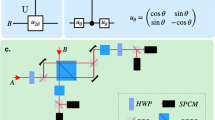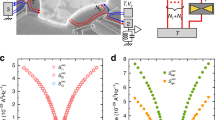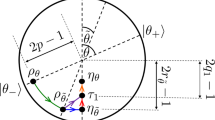Abstract
Electronic circuits operating at sub-kelvin temperatures are attractive candidates for studying classical and quantum thermodynamics: their temperature can be controlled and measured locally with exquisite precision, and they allow experiments with large statistical samples. The availability and rapid development of devices such as quantum dots, single-electron boxes and superconducting qubits only enhance their appeal. But although these systems provide fertile ground for studying heat transport, entropy production and work in the context of quantum mechanics, the field remains in its infancy experimentally. Here, we review some recent experiments on quantum heat transport, fluctuation relations and implementations of Maxwell’s demon, revealing the rich physics yet to be fully probed in these systems.
This is a preview of subscription content, access via your institution
Access options
Subscribe to this journal
Receive 12 print issues and online access
$209.00 per year
only $17.42 per issue
Buy this article
- Purchase on Springer Link
- Instant access to full article PDF
Prices may be subject to local taxes which are calculated during checkout




Similar content being viewed by others
References
Seifert, U. Stochastic thermodynamics, fluctuation theorems, and molecular machines. Rep. Prog. Phys. 75, 126001 (2012).
Alemany, A. & Ritort, F. Fluctuation theorems in small systems: Extending thermodynamics to the nanoscale. Europhys. News 41, 27–30 (2010).
Alemany, A., Ribezzi, M. & Ritort, F. in Nonequilibrium Statistical Physics of Small Systems: Fluctuation Relations and Beyond (eds Klages, R., Just, W. & Jarzynski, C.) (Wiley-VCH, 2012).
Giazotto, F., Heikkilä, T. T., Luukanen, A., Savin, A. M. & Pekola, J. P. Opportunities for mesoscopics in thermometry and refrigeration: Physics and applications. Rev. Mod. Phys. 78, 217–274 (2006).
Courtois, H., Hekking, F. W. J., Nguyen, H. Q. & Winkelmann, C. Electronic coolers based on superconducting tunnel junctions: Fundamentals and applications. J. Low Temp. Phys. 175, 799–812 (2014).
Prance, J. R. et al. Electronic refrigeration of a two-dimensional electron gas. Phys. Rev. Lett. 102, 146602 (2009).
Pendry, J. B. Quantum limits to flow of information and entropy. J. Phys. A 16, 21612171 (1983).
Schwab, K., Henriksen, E. A., Worlock, J. M. & Roukes, M. L. Measurement of the quantum of thermal conductance. Nature 404, 974–977 (2000).
Meschke, M., Guichard, W. & Pekola, J. P. Single-mode heat conduction by photons. Nature 444, 187–190 (2006).
Timofeev, A. V., Helle, M., Meschke, M., Möttönen, M. & Pekola, J. P. Electronic refrigeration at the quantum limit. Phys. Rev. Lett. 102, 200801 (2009).
Ciliberto, S., Imparato, A., Naert, A. & Tanase, M. Heat flux and entropy produced by thermal fluctuations. Phys. Rev. Lett. 110, 180601 (2013).
Jezouin, S. et al. Quantum limit of heat flow across a single electronic channel. Science 342, 601–604 (2013).
Blanter, Y. M. & Büttiker, M. Shot noise in mesoscopic conductors. Phys. Rep. 336, 1–166 (2000).
Averin, D. V. & Pekola, J. P. Violation of the fluctuation-dissipation theorem in time-dependent mesoscopic heat transport. Phys. Rev. Lett. 104, 220601 (2010).
Sergi, D. Energy transport and fluctuations in small conductors. Phys. Rev. B 83, 033401 (2011).
Zhan, F., Denisov, S. & Hänggi, P. Power spectrum of electronic heat current fluctuations. Phys. Status Solidi B 250, 2355–2364 (2013).
Evans, D. J., Cohen, E. G. D. & Morriss, G. P. Probability of second law violations in shearing steady states. Phys. Rev. Lett. 71, 2401–2404 (1993).
Utsumi, Y. et al. Bidirectional single-electron counting and the fluctuation theorem. Phys. Rev. B 81, 125331 (2010).
Küng, B. et al. Irreversibility on the level of single-electron tunneling. Phys. Rev. X 2, 011001 (2012).
Cuetara, G. B., Esposito, M., Schaller, G. & Gaspard, P. Effective fluctuation theorems for electron transport in a double quantum dot coupled to a quantum point contact. Phys. Rev. B 88, 115134 (2013).
Golubev, D. S., Utsumi, Y., Marthaler, M. & Schön, G. Fluctuation theorem for a double quantum dot coupled to a point-contact electrometer. Phys. Rev. B 84, 075323 (2011).
Nakamura, S. et al. Nonequilibrium fluctuation relations in a quantum coherent conductor. Phys. Rev. Lett. 104, 080602 (2010).
Jarzynski, C. Nonequilibrium equality for free energy differences. Phys. Rev. Lett. 78, 2690–2693 (1997).
Crooks, G. E. Entropy production fluctuation theorem and the nonequilibrium work relation for free energy differences. Phys. Rev. E 60, 2721–2726 (1999).
Büttiker, M. Zero-current persistent potential drop across small-capacitance Josephson junctions. Phys. Rev. B 36, 3548–3555 (1987).
Averin, D. V. & Likharev, K. K. in Mesoscopic Phenomena in Solids (eds Altshuler, B. L., Lee, P. A. & Webb, R. A.) 173–271 (Elsevier, 1991).
Lafarge, P. et al. Direct observation of macroscopic charge quantization. Z. Phys. B 85, 327–332 (1991).
Averin, D. V. & Pekola, J. P. Statistics of the dissipated energy in driven single-electron transitions. Europhys. Lett. 96, 67004 (2011).
Saira, O-P. et al. Test of Jarzynski and Crooks fluctuation relations in an electronic system. Phys. Rev. Lett. 109, 180601 (2012).
Koski, J. V. et al. Distribution of entropy production in a single-electron box. Nature Phys. 9, 644–648 (2013).
Seifert, U. Entropy production along a stochastic trajectory and an integral fluctuation theorem. Phys. Rev. Lett. 95, 040602 (2005).
Toyabe, S., Sagawa, T., Ueda, M., Muneyuki, E. & Sano, M. Experimental demonstration of information-to-energy conversion and validation of the generalized Jarzynski equality. Nature Phys. 6, 988–992 (2010).
Strasberg, P., Schaller, G., Brandes, T. & Esposito, M. Thermodynamics of a physical model implementing a Maxwell Demon. Phys. Rev. Lett. 110, 040601 (2013).
Koski, J. V., Maisi, V. F., Pekola, J. P. & Averin, D. V. Experimental realization of a Szilard engine with a single electron. Proc. Natl Acad. Sci. USA 111, 13786–13789 (2014).
Koski, J. V., Maisi, V. F., Sagawa, T. & Pekola, J. P. Experimental observation of the role of mutual information in the nonequilibrium dynamics of a Maxwell Demon. Phys. Rev. Lett. 113, 030601 (2014).
Landauer, R. Irreversibility and heat generation in the computing process. IBM Res. J. Dev. 5, 183–191 (1961).
Bérut, A. et al. Experimental verification of Landauer’s principle linking information and thermodynamics. Nature 483, 187–189 (2012).
Sagawa, T. & Ueda, M. Generalized Jarzynski equality under nonequilibrium feedback control. Phys. Rev. Lett. 104, 090602 (2010).
Kurchan, J. A quantum fluctuation theorem. Preprint at http://arxiv.org/abs/cond-mat/0007360 (2000).
Talkner, P., Lutz, E. & Hänggi, P. Fluctuation theorems: Work is not an observable. Phys. Rev. E 75, 050102(R) (2007).
Esposito, M., Harbola, U. & Mukamel, S. Nonequilibrium fluctuations, fluctuation theorems, and counting statistics in quantum systems. Rev. Mod. Phys. 81, 1665–1702 (2009).
Campisi, M., Hänggi, P. & Talkner, P. Colloquium: Quantum fluctuation relations: Foundations and applications. Rev. Mod. Phys. 83, 771–791 (2011).
Makhlin, Y., Schön, G. & Shnirman, A. Quantum-state engineering with Josephson-junction devices. Rev. Mod. Phys. 73, 357–400 (2001).
Clarke, J. & Wilhelm, F. K. Superconducting quantum bits. Nature 453, 1031–1042 (2008).
Pekola, J. P., Solinas, P., Shnirman, A. & Averin, D. V. Calorimetric measurement of work in a quantum system. New J. Phys. 15, 115006 (2013).
Schmidt, D. R., Yung, C. S. & Cleland, A. N. Nanoscale radio-frequency thermometry. Appl. Phys. Lett. 83, 1002–1004 (2003).
Govenius, J. et al. Microwave nanobolometer based on proximity Josephson junctions. Phys. Rev. B 90, 064505 (2014).
Gasparinetti, S. et al. Fast electron thermometry towards ultra-sensitive calorimetric detection. Preprint at http://arxiv.org/abs/1405.7568 (2014).
Dorner, R. et al. Extracting quantum work statistics and fluctuation theorems by single-qubit interferometry. Phys. Rev. Lett. 110, 230601 (2013).
Mazzola, L., Chiara, G. D. & Paternostro, M. Measuring the characteristic function of the work distribution. Phys. Rev. Lett. 110, 230602 (2013).
Campisi, M., Blattmann, R., Kohler, S., Zueco, D. & Hänggi, P. Employing circuit QED to measure nonequilibrium work fluctuations. New J. Phys. 15, 105028 (2013).
Van den Broeck, C. & Kawai, R. Brownian refrigerator. Phys. Rev. Lett. 96, 210601 (2006).
Pekola, J. P. & Hekking, F. W. J. Normal-metal-superconductor tunnel junction as a brownian refrigerator. Phys. Rev. Lett. 98, 210604 (2007).
Acknowledgements
I thank J. Koski and M. Campisi for comments on the manuscript, and A. Feshchenko for providing illustration material. This work has been supported in part by the European Union Seventh Framework Programme INFERNOS (FP7/2007-2013) under grant agreement no. 308850, and by Academy of Finland (projects 250280 and 272218).
Author information
Authors and Affiliations
Corresponding author
Ethics declarations
Competing interests
The author declares no competing financial interests.
Rights and permissions
About this article
Cite this article
Pekola, J. Towards quantum thermodynamics in electronic circuits. Nature Phys 11, 118–123 (2015). https://doi.org/10.1038/nphys3169
Received:
Accepted:
Published:
Issue Date:
DOI: https://doi.org/10.1038/nphys3169
This article is cited by
-
Charging and self-discharging process of a quantum battery in composite environments
Frontiers of Physics (2023)
-
Identifying optimal cycles in quantum thermal machines with reinforcement-learning
npj Quantum Information (2022)
-
Free energy amplification by magnetic flux for driven quantum systems
Communications Physics (2021)
-
Quantum thermodynamics of single particle systems
Scientific Reports (2020)
-
Experimental characterization of the energetics of quantum logic gates
npj Quantum Information (2020)



